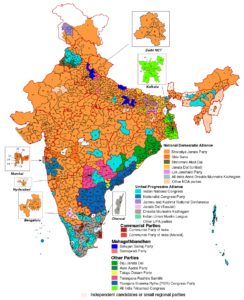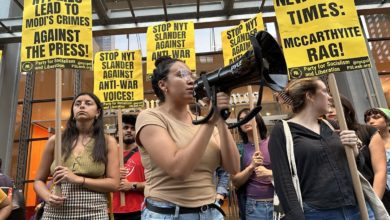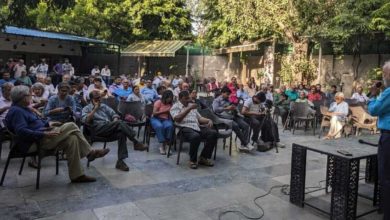 India, touted as the “world’s biggest democracy” in the corporate media, conducted its bitterly fought national election recently, with final results announced at the end of May. The incumbent ultra-rightwing party, the Bharatiya Janata Party, came back to power with a greater majority than before with Prime Minister Narendra Modi set to remain as the country’s leader.
India, touted as the “world’s biggest democracy” in the corporate media, conducted its bitterly fought national election recently, with final results announced at the end of May. The incumbent ultra-rightwing party, the Bharatiya Janata Party, came back to power with a greater majority than before with Prime Minister Narendra Modi set to remain as the country’s leader.
The campaign was the costliest election ever conducted in the world; a whopping $8.7 billion spent – $2 billion more than the total expenditure in 2016 US presidential election. Most of that money was spent by the winning party. The election re-established the BJP’s majority in the parliament by itself – 303 seats out of 545 parliamentary seats. Even though the BJP ran the election with a coalition, it does not need any coalition partners to control parliament. The BJP increased its overall vote share from 31 percent to 38 percent, with its coalition’s vote share being 45 percent. In every three of the four seats won by BJP, its vote share was more than 50 percent.
Why did the BJP win?
The BJP achieved such a huge electoral victory despite its five years of rule leading to record high unemployment, massive agrarian distress with alarming numbers of farmers committing suicide, a falling Gross Domestic Product growth rate, a mega-corruption accusation relating to the purchase of Dassault Rafale fighter planes from France implicating directly the Prime Minister’s office and growing bigotry and sectarianism especially against Muslims. On top of that were two major botched policies implemented by the Modi government which contributed to the worsening state of India’s economy. One is referred to as “demonetization” and the other is the enactment of the Goods and Service Tax
Demonetization was done in 2016 directly at the order of Modi, against the advice of the Indian central bank. The policy meant certain denomination banknotes were rapidly withdrawn from circulation with the pretext that this would curtail corruption and illicit terror funding. This led to severe cash shortages affecting mostly the cash dependent working class people and farmers in rural areas. The shock of that led to the reduction of GDP growth.
In 2017, the BJP government introduced the GST – a single-packaged tax which is levied at the time of consumption replacing all other previous consumption taxes such as sales tax and excise tax. The high rates of GST, its complicated codes and bungled up implementation took a hit on small business in India. Both demonetization and GST affected India’s construction sector, which had been creating the most jobs.
As a campaign tactic the BJP managed to conceal and divert the narrative away from these concrete material issues into the question of “national security” by saber-rattling against India’s neighbor Pakistan, fully projecting the cult of personality of Modi, promoting extreme religious communal polarization achieved by dog whistling against the Muslim minority population and by embracing Hindu majoritarianism. Muslims constitute 15 percent of India’s population – roughly 180 million people.
The national security narrative characterized by extreme anti-Pakistan jingoism was particularly effective due to a suicide bombing that killed 45 persons of the Central Reserve Police Force, a paramilitary institution midway between the police and the regular army. The attack took place two months before the election and was carried out by a separatist religious fundamentalist organization in Kashmir, which is one of the most militarized regions in the world. This was a perfect wag-the-dog moment for Modi. He ordered an Israeli style airstrike with so called “smart bombs” supplied by Israel inside Pakistan’s territory with the claim that the airstrike destroyed the training camp of the organization that had taken the responsibility of the terror attack.
Even though there were severe doubts the airstrike really achieved anything other than bringing India and Pakistan, two nuclear-armed states, dangerously close to war, that airstrike helped build a muscular image for Modi inside India and he took Trump-esque personal credit for it. Modi in one campaign speech said, “Our nuclear weapons are not for Diwali,” referring to the festival where people use fireworks to celebrate.
Money, uncritically pliant mass media and institutional collapse also aided Modi’s victory. The Indian Election Commission, which had been historically a strong and impartial institution, lost its professional credibility with complicit silence and inaction when Modi and BJP’s party president Amit Shah broke several model codes of conduct during the campaign.
Modi has cultivated a cult of personality with the implication that any social welfare scheme that happened was due to Modi’s personal magnanimity. Propane tanks were given to rural households at subsidized costs and toilets were built. Even though the actual effectiveness of those schemes are very much in doubt, they were heavily propagandized as Modi’s own – which also seems to have had an electoral effect.
The Indian stock market boomed to a record high after the election results were announced, with the shares of crony capitalists– known to be close to BJP and expected to reap benefit from their investment in BJP, such as Adani’s– outperforming others exceptionally. Modi’s government had earlier altered the electoral funding rules to allow secret political donation in the form of electoral bonds even from international capitalist donors. BJP got 90 percent of the total electoral bonds leading up to the election.
Modi promotes far-right ideology: Hinduvata
In the victory speech, Modi described India now as having two castes of people – one caste consisting of those who are poor and the other caste consisting of people who will remove poverty. On the surface of it such a classification might sound like a very peculiar reactionary innovation, but it is nothing but neoliberal capitalism repackaged with a makeover of BJP’s earlier ideology. Such phrasing also erases two key components of people’s politics in India – class and caste.
BJP’s ideological origin goes back to Hindu nationalism otherwise known as Hindutva. Hindutva constructs India as exclusively a nation for the Hindus, while taking inspiration and modeling itself from German and Italian fascism of the 1930s. At that time, political formations subscribing to Hindutva, such as the RSS and the Hindu Mahasabha, remained mostly at the fringe and did not really take part in the Indian national struggle for decolonization from Britain.
Hindutva was always incoherently articulated by its early ideologues. Later it was integrated into a much more coherent ideology named Integral Humanism, espoused by Deendayal Upadhaya, the founding president of the political party, Jan Sangh, that was precursor to BJP. Integral Humanism remains BJP’s philosophy. The theory of Integral Humanism rejects the Marxist notion of class struggle. According to this theory, the associations or loyalties people have are either civilizational, cultural or religious. In such a construct there is no class struggle between say a Hindu capitalist and a Hindu worker – they rather work together in symbiosis for a common goal in the service of a Hindu nation.
This rejection of class struggle has been consistently reflected by the BJP. For example, the BJP affiliated trade unions boycotted the nationwide strike in January this year when 150 million workers of India led by the communist and socialist unions. This action was the largest strike in world history.
Caste in India, like race in the United States, is a historical construction grounded in a material basis. It was used in the feudal phase for wealth accumulation – the actual wealth and value producing class were relegated to lower castes, and people exploiting the fruit of the labor were the upper castes consisting of Brahmins – i.e. the priest caste, warriors and merchants. Caste was the crystallization of hereditary class. The exploiting class then came up with explicit apartheid social codification based on rigid power hierarchy of upper caste supremacy, identified as Brahminical ideology, to not only exploit but also exclude and oppress the lower castes.
The most oppressed in this solid structure, for example hereditary workers in the in the leather industry or workers in the sanitation service, are considered the Dalits, literally meaning the oppressed. Caste in India could be considered as the oldest continuing racist structure in the world. With the withering away of feudal modes of production, caste still persists in India even under capitalism – with capitalists almost always coming from the historically exploiting upper castes.
BJP does not offer any transformational politics to counter the caste system — far from it. The BJP instead doubles down on its core reactionary Hindutva that is compatible with Brahminical ideology and tries to create a Hindu national consciousness by branding Muslims as enemy aliens. A centerpiece of this approach is the demand for the construction of a Hindu temple in the town of Ayodhya for a mythical warrior Hindu king, Ram, at the site of a Muslim mosque that has now been destroyed. The right-wing says that the mosque was built on the site of a mythical Hindu temple some 500 years ago.
Since that time, BJP with other Hindutva proxies managed to recruit some foot soldiers from the exploited and oppressed castes to use them against Muslims. In 2002, when Modi was the chief minister of a western province of Gujarat, a state-aided pogrom was orchestrated killing 2,000 Muslims. Communal polarization based on a religious divisive agenda remains the key modus operandi of BJP to win elections. In India’s biggest state of Uttar Pradesh, home to over 200 million people, the BJP came back to power in 2017 after 15 years in opposition. The current Chief Minister of Uttar Pradesh, Adityanath, a Hindu monk, has been himself accused of taking part in communal violence. His government has also been accused of killing several young Muslim men in an extrajudicial manner.
Political upheaval in several major states
In the current election an alliance in Uttar Pradesh between a major party of the Dalits – Bahujan Samajwadi Party (The Socialist Part of the majority, BSP) and another party representing traditionally middle exploited castes – the Samajwadi Party (The Socialist Party, SP), lost many seats to the BJP.
The BJP also made strong in-roads to the province of West Bengal, where the Communist Party of India (Marxist) had ruled from 1982 to 2016, by explicitly taking up a Hindutva communal line and by dog whistling against Muslim immigrants from Bangladesh. BJP’s Bengal strategy was seen in big-money-powered rallies filled with violence where its slogan was “Jai Shri Ram” (Hail to Lord Ram!). The BJP wants to pass a Citizenship Amendment Bill that will exclude Muslim immigrants from India’s neighboring countries from becoming Indian citizens. BJP’s party president Amit Shah made it a top campaign issue to polarize voters, both in Bengal and other states in the northeast of India.
In the southern province of Kerala, which is ruled on the state level by a coalition of communists, BJP leaned heavily on the religious fundamentalist, patriarchal demand that women not be allowed to enter the temple of Sabarimala. The bourgeois liberal party Congress equivocated on this issue. It was only the local communist government that stood with a principled stance and supported women’s right to enter the temple. Even though BJP didn’t manage to leverage this issue fully, it increased its vote share in Kerala by a few percentage points.
The only state in India where BJP performed very badly was in Tamil Nadu in the south. A local political alliance between the DMK — a progressive party that opposes caste discrimination — along with the traditionally ruling Indian National Congress and two communist parties acted as an electorally successful bulwark against the far right. In all other places the BJP either won seats or increased its vote share.
What next for India under far-right rule?
The BJP intends to continue its attempts to mobilize people with divisive reactionary chauvinism which has the fascistic essence of terrorizing India’s minorities, communists and socialists, anti-caste activists, and even liberals with state-sanctioned street violence.
Right before the Indian election, Steven Rattner, counselor to the Treasury secretary during the Obama administration, wrote an op-ed in the New York Times lauding Modi: “For his part, Mr. Modi should recognize the importance of a less statist approach and pursue with more vigor important initiatives like deregulation and privatization of state-owned companies. A bit more Thatcherism would serve India well.” Modi himself had earlier mentioned “Government has no business being in business.” In his first term Modi put this into practice by privatizing a record number of state-owned resources valued at $48 billion and writing off $50 billion worth of corporate loans.
Institutionalizing ultra-rightwing reactionary chauvinism and also operating the state as a neoliberal manager are two somewhat contradictory goals for Modi. This is not unique to India. All over the world there has been a rightward shift arising from the failure of capitalism since the great crash of 2008. The election of Donald Trump in the U.S. and of Jair Bolsonaro in Brazil, Italy’s Matteo Salvini’s skyrocketing popularity and so on, are part of the same trend. Global capitalism for its own survival has shown it can easily change from supporting bourgeois liberalism to reactionary right-wing authoritarians. The operating procedure for Modi to manage these contradictions has been to increasingly hand over the state’s economic control to capitalists while increasing ultra-rightwing authoritarian structures to control the Indian people. The head of the Indian government’s economic advisor body, the Niti Ayog, has made it clear after the election that privatization of state’s resources and banks and reactionary changes to labor laws are some of the top priorities for the government.
The main opposition party, the Indian National Congress, has a very similar track record of neoliberalism like BJP. In this election it failed to form the urgently needed united front coalition with other secular, democratic forces. This again demonstrates the failure of bourgeois liberalism to counter the growth of the far right.
The Indian left has led powerful struggles on the ground battling both capitalism and the religious fundamentalist bigotry of the BJP. Modi’s neoliberal management will be incapable of leading people out of their current state of unemployment and desperation. To divert its material failures, Modi’s regime will continue to unleash the reactionary ultra-rightwing agenda. Having the correct analysis while leading on-the-ground struggles is the only way forward to counter this neoliberalism with an ultra-rightwing face. The left in India has a hard task ahead, but it has over a century of experience in heroic revolutionary struggle to draw on as it faces this dangerous period.





